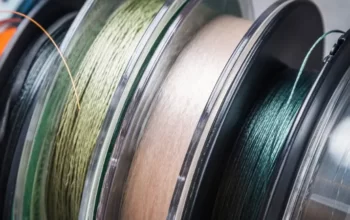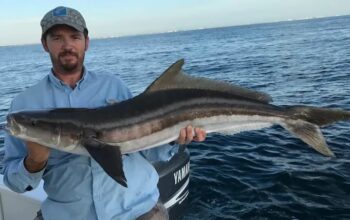Freshwater fish called gar are native to North America and have been around for more than 100,000,000 years. They make excellent sport fish. In addition to being vicious predators who will consume almost anything, gar can grow to be up to 8 feet long and weigh more than 300 pounds. Consider rigging your lure for one of the following five species if you want an unforgettable fishing experience: Longnose, shortnose, spotted, or Florida alligator.
In this post, we will explain everything you need to know how to catch gar.
Table of Contents
Characteristics Of The Gar
First of all we have to say that in this post we are talking about gar fish, the North American freshwater fish of the family Don’t mistake it for garfish or needlefish by calling it the Lepisosteidae family (Belone Belone). Gars are also sometimes referred to as “garpike,” despite the fact that they are not closely related to pike, which belongs to the fish family Esocidae.
Gars are large fish with elongated bodies and also elongated jaws filled with long, sharp teeth. The largest gar is the alligator gar (Atractosteus spatula), which can reach lengths of over 2 meters (6.5 feet) and weights of over 45 kilograms (100 lb). One of the curiosities of this species is that they have vascularised swim bladders that can function as lungs, so sometimes gars go up to the surface periodically to gulp air.
Types Of Gar
There are only seven species of Gar that are still alive; the others are still around. They are:
- Alligator Gar (The tractosteus spatula Because it frequently passed for an alligator by locals, the largest member of the gar family is known as that.
- Spotted Gar (“Lepisosteus oculatus”): It is a smaller species of gar with dark spots all over its head, body, and fins.
- Longnose Gar (Lepisosteus osseus): The alligator gar’s smaller counterpart. Its snout, which is longer than the rest of its head by more than twice as much, sets it apart from other gar species.
- Shortnose Gar (Lepisosteus platostomus): It gets its name from the fact that its snout is shorter and wider than those of other gar species.
- Florida Gar ((Lepisosteus platyrhincus) it can be found in the It’s frequently mistaken for the spotted gar and is found in the Ocklockonee River, Florida, and Georgia.
- Cuban Gar (Atractosteus tristoechus)
- Tropical Gar (Atractosteus tropicus)
Where And When Can You Find Gar?
The best gar fishing is available during the sweltering summer months. Finding fish shouldn’t be too difficult in reputable waters. The majority of the time, especially at dawn, dusk, and at night, they roll loudly close to the surface. They can gulp air to help their gills breathe thanks to a lung-like air bladder.
Gar can be found in all sizes of bodies of water, from tiny creeks to enormous impoundments, but some of the best fishing is in oxbow lakes, bayous, and slow-moving delta rivers. The mouths of in-flowing tributaries, outside stream bends, sandbar/river channel abuttals, quiet backwater pools, and lock and dam tailwaters are some of the hotspots for flowing water. Fish in shallow areas near the edges of weedy and wooded cover on lakes.
Best Conditions To Catch Gar
This species’ activity typically begins at the end of May, peaks in the summer, and continues into September, October, and sometimes even the beginning of November. When water temperatures rises (from 70°F to 90°F) gar feed more actively and there’s a lot of surface activity, so hot summer months as July and August are best for catching gar. Because they can see the lures and you can see the fish close to the surface, the best days are those that are warm, clear, and sunny.
But if you really want to be sure of the optimal weather conditions to catch the gar, we recommend using the When you keep track of your various gar catches in your fishing journal, WeFish Fishlab will enable you to play around with them and find out under what weather conditions you catch this species the most: air and water temperature, wind speed, months of the year, moon phases, pressure atmospheric… so it is impossible to fail!

Fishing Gear For Gar
Gar are powerful fish that demand a powerful fishing setup akin to what you’d use for inshore fishing. Depending on the species, some gar, like alligator gar and longnose gar, can grow to be over 6 feet long and weigh up to 100 pounds. I’d advise using tackle capable of handling a fish weighing at least 30 pounds. Below are a few of the rods, reels, and lines that I personally use. However, you should also take a look at any of the inshore spinning rods and reels on this list because they are all ideal for gar fishing.
Rods
Gar fishing rods must have some backbone to withstand powerful runs. A 7-foot rod with a 10–20-pound weight rating is a good place to start. Gar rods can also be used for catfish and inshore fishing. If you’re looking for more options, check out these additional gar rods.
Line
Fluorocarbon or braid fishing line with a test of 20 to 40 pounds is recommended for gar. Since gar have very sharp teeth and can quickly break the line, I would also advise using a wire leader. Use a 50lb fluoro or mono leader at the very least.
Reels
For gar fishing, a high-quality reel with a strong drag is a requirement. Uneven drag can affect the amount of force on the line at any given time and increase the likelihood that it will snap. When attempting to use a less expensive reel, I personally encountered this problem. It wasn’t what you wanted to see when I hooked a big fish because when it ran and pulled drag, the reel itself bent at the foot where it was attached to the rod and the line flew off the spool like when I try to hula hoop. These are my go-to reels because they have a smooth, strong drag, but if they don’t suit your needs, you might want to check out some other reels as well.
Accessories
Although these extras aren’t required, they are something to consider if you value your fingers, especially if you’re fishing for alligator gar. Since treble hooks are usually used to catch gar, you will need to get your hands inside and close to their mouth because the teeth are sharp.
Bait And Lures For Gar
Gar are experts at stalking their prey slowly before violently lashing out with their bony, tooth-lined bill to seize baits and minnows. It is incredibly cunning and terrifying to witness. Try the following baits to catch gar:
- Frayed nylon rope – continue reading Techniques for how to use this
- Live bait such as perch or shiners on a 5/0 treble hook under a float
- Cut bait such as fish chunks or chicken wrapped with a nylon rope
- Crankbaits and topwater plugs with treble hooks – you will need every single one of those hooks
Fishing Techniques For Gar
When compared to bass fishing or saltwater fishing, gar fishing techniques can be quite novel. In fact, some of these strategies are utterly absurd, but they work very well. Try them out; trying to catch fish in a new way can be both entertaining and challenging. To find out how to legally take gar, make sure to first check your state’s fishing laws.
Topwater Tactics
The majority of gar fishing is done by sight fishing. Gar fishing is almost exclusively done by finding them and casting to a school or gar. It’s thrilling to use a topwater plug or crank to catch a gar, but you have to be very patient. When you find a gar, cast your lure just in front of it, and then leave it alone, giving it only the sporadic flick of the line. In contrast to other fish that actively strike, the gar will approach the lure very slowly if it is feeding. It approaches covertly and waits until the lure is directly in front of its head before acting. Keep your lure stationary at all times. Then, with just the slightest twitch, it turns on! The crankbait will be snapped at by the gar with a sideways slash, and it will run off with it. Set the treble hooks into the bony bill of the gar with several forceful attempts, and then hold on.
Fly Fishing For Gar
The closest freshwater experience to tarpon on a fly can be had by throwing a light fly and waiting for a gar to strike. This enormous fish will be challenging to hook and to fight due to its bony mouth. One day, I would love to be able to catch a gar on a fly; it’s definitely on my bucket list. Even better, create your own nylon rope fly and give it a shot.
Catching Gar With Nylon Rope
Using a small length of nylon rope fastened to a wire leader is another productive gar-fishing technique that many people have heard of but have never tried. Cast a bucktail-style lure with a fluffy end made from a few inches of rope near surfacing gars. As they strike the rope, the fine threads will entangle themselves in their teeth. It really works well and doesn’t require any hooks.
Bow Fishing
It is possible to use a bow to fish for gar in states where they are not regarded as game fish. This is a challenging way to learn about bowfishing, but it’s also a unique and entertaining way to start gar fishing. Although I hunt with a bow and have never bow fished, I would love to try it. You can buy something already set up, like the Cajun Bow made by PSE, or you can add a reel to your existing bow.
Lasso For Gar
This method of fishing for gar is quite inventive. It seems like Texas is where lasso fishing for gar was first developed. It entails snaring gar with a noose and baitfish using a thin wire. A noose is constructed around the bait after it has been impaled on the end of a wire. The wire noose closes around the gar’s bill as soon as it eats the bait, and the bird takes off.
Can You Eat Gar?
Yes, you can, but be ready to put in a lot of work. Look at the scales that resemble armor in the images up top and then imagine all the bones inside. I’ve heard people actually say that a Sawzall and a pair of tin snips can be used to filet a gar. For a steak with an average flavor and the consistency of alligator or chicken, that seems like way too much work to me. Also keep in mind that the eggs are poisonous. As much as I like fresh fish, I’ll opt for the sporting value over the meat value in this instance and leave the power tools at home. I’m always able to order fresh fish to eat.
Conclusion
So far, everything you need to know to fish for gar, a star species for American freshwater anglers Please don’t be shy about leaving a comment if you have any inquiries or suggestions! Download the best fishing app for free to plan your journey the next time you go fishing for a gar.




